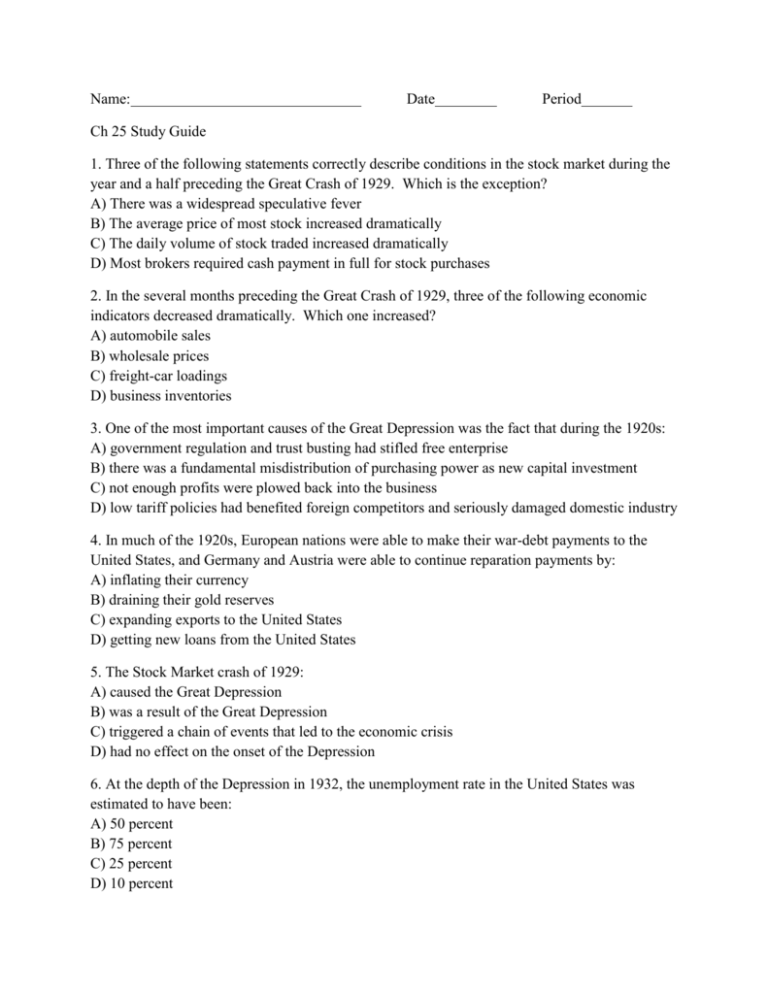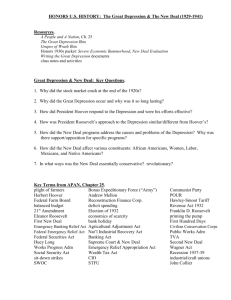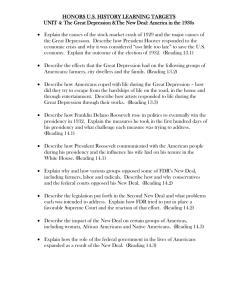Name: Date Period Ch 25 Study Guide 1. Three of the following
advertisement

Name: Date Period Ch 25 Study Guide 1. Three of the following statements correctly describe conditions in the stock market during the year and a half preceding the Great Crash of 1929. Which is the exception? A) There was a widespread speculative fever B) The average price of most stock increased dramatically C) The daily volume of stock traded increased dramatically D) Most brokers required cash payment in full for stock purchases 2. In the several months preceding the Great Crash of 1929, three of the following economic indicators decreased dramatically. Which one increased? A) automobile sales B) wholesale prices C) freight-car loadings D) business inventories 3. One of the most important causes of the Great Depression was the fact that during the 1920s: A) government regulation and trust busting had stifled free enterprise B) there was a fundamental misdistribution of purchasing power as new capital investment C) not enough profits were plowed back into the business D) low tariff policies had benefited foreign competitors and seriously damaged domestic industry 4. In much of the 1920s, European nations were able to make their war-debt payments to the United States, and Germany and Austria were able to continue reparation payments by: A) inflating their currency B) draining their gold reserves C) expanding exports to the United States D) getting new loans from the United States 5. The Stock Market crash of 1929: A) caused the Great Depression B) was a result of the Great Depression C) triggered a chain of events that led to the economic crisis D) had no effect on the onset of the Depression 6. At the depth of the Depression in 1932, the unemployment rate in the United States was estimated to have been: A) 50 percent B) 75 percent C) 25 percent D) 10 percent 7. The Dust bowl: A) was caused solely by a particularly bed drought B) was largely a result of farming practices of the Great Plains C) caused the dust from the plains to blow as far as Chicago D) only lasted for about a year 8. In the early 1930s, the term “Okies” referred to: A) moonshiners trying to make a living in Appalachia B) oil speculators losing money in the Southwest C) swamp dwellers out of the mainstream in the Deep South D) dispossessed farmers fleeing the Dust Bowl 9. Three of the following statements accurately describe the condition of blacks during the Great Depression. Which is the exception? A) The migration of blacks to the North ended abruptly B) Blacks suffered a higher unemployment rate than whites C) Discrimination against blacks increased, particularly in competition for jobs D) Local government and private relief for blacks were smaller than for whites 10. In the 1920s, the great majority of Hispanics in California and the American Southwest originally migrated from: A) Cuba B) Mexico C) Puerto Rico D) none of these, for Hispanics were specifically excluded by the immigration laws of the early 1920s 11. One effect of the Great Depression on women was to: A) Open up new opportunities for women in the professions B) Strengthen the belief that a woman’s place was in the home C) Drive most women out of the labor force by the time the economic crisis was over D) Gain increased public support for such feminist organizations as the National Woman’s Party 12. Three of the following were effects of the Great Depression on the American family. Which is the exception? A) The birth rate declined B) The marriage rate declined C) The divorce rate increased D) Middle-class families as well as working-class families suffered great traumatic impact 13. Popular culture during the Depression era, as manifested by radio, movies, and literature, was generally characterized by: A) upbeat and romantic messages as a sort of escapism B) appeals to prurient interests in sex and crime C) a return to traditional religious values D) a deep social concern to portray the human consequences of the national economic disaster 14. Three of the following novels manifest an implicit protest against social injustices in thencontemporary American society. Which is the exception? A) Erskine Caldwell’s Tobacco Road (1932) B) Margaret Mitchell’s Gone with the Wind (1936) C) John Steinbeck’s Grapes of Wrath (1939) D) Richard Wright’s Native Son (1940) 15. Movie attendance during the Depression: A) rose throughout the decade B) fell throughout the decade C) rose initially but then fell as the Depression worsened D) fell initially but then rose as the Depression worsened 16. The Popular Front: A) was a radio show about detectives in New York City B) was a broad coalition of “antifascist” groups in the political left C) was one of the most successful programs of the New Deal D) was a name given to the Nazi party by the State Department 17. The Abraham Lincoln brigade was most closely associated with: A) Coxey’s Army B) the Bonus Army C) the Spanish Civil War D) veterans of the American Expeditionary Force in World War I 18. The tactics pursued by the American Communists Party between 1935 and 1939 were aimed at developing a broad alliance against: A) fascism B) Franklin Delano Roosevelt C) racial injustice D) nonpolitical unionism 19. For the eight years immediately before becoming president, Herbert Hoover had been the: A) vice president B) secretary of state C) secretary of commerce D) Speaker of the House of Representative 20. The purpose of the Agricultural Marketing Act, proposed by Herbert Hoover even before the Great Crash if 1929, was to: A) keep farm prices up B) impose government regulations in the commodities exchange market C) establish quotas for the importation of foreign agricultural products D) promote reciprocal trade agreements with foreign countries for agricultural products 21. Hoover’s first efforts to control the Depression focused on: A) a recovery program for the banking industry B) voluntary cooperation by business leaders in restoring the public confidence in the economy C) a massive federal relief bill D) all of the above 22. After the effects of the Depression spread to Europe, in an attempt to restore international economic stability, Hoover proposed: A) a cancellation of war debts owed to the United States B) a moratorium on war debts, reparations, and private international debts C) that the United States followed Europe’s lead in going off the gold standard D) that the United States, by means of massive loans, help the European countries to maintain the gold standard 23. Hoover’s measures to deal with the Depression included support for three of the following. Which is the exception? A) A large-scale federal program of direct relief to the unemployed B) A system of government home-loan banks to assist mortgage holders C) The Reconstruction Finance Corporation to make loans to businesses D) The Hawley-Smoot Tariff to protect agriculture from foreign competition 24. The Reconstruction Finance Corporation was largely ineffective in promoting recovery from the Depression because: A) the Supreme Court declared it unconstitutional B) its activities did not gain the support of President Hoover C) its programs benefited primarily the small banks and family corporations D) it was underfunded and overcautious in the use of the funds it did have 25. When it was first organized, how did the Farmers’ Holiday Association seek to gain higher prices for farm products? A) by lobbying in Washington B) by withholding crops from the market C) by running its own candidates for state legislature D) by establishing its own cooperative marketing facilities 26. One important cause of the great stock market crash of 1929 was A) overexpansion of production and credit beyond the ability to pay for them B) a “tight” money policy that made it difficult to obtain loans C) the lack of traffic protection for American markets from foreign competitors D) excessive government regulation of business 27. The federal agency that Hoover established to provide “pump-priming” loans to business was the A) Tennessee Valley Authority B) Bonus Expeditionary Force C) Reconstruction Finance Corporation D) American Legion 28. Which of the following methods of fighting the Depression did President Herbert Hoover oppose throughout his administration?: A) federal welfare programs to give relief directly to the poor B) an increase of taxes on wealthy individuals and corporations C) loans by the government to big businesses to keep them from failing D) increased state and local spending for public works programs E) continued promotion of cooperation and conferences between government and business 29. One effect of the Great Depression on women was to?: A) open up new opportunities for women in the profession B) drive most women out of the labor force by the time the economic crisis was over C) strengthen the belief that a woman’s place was in the home D) gain increased public support for such feminist organizations as the National Woman’s Party 30. The Reconstruction Finance Corporation?: A) was passed over Hoover’s veto B) offered emergency loans to banks, farm mortgage associations, building and loan societies, and other such businesses to prevent bankruptcies C) was criticized for its alleged favoritism to farmers and workers D) all of these choices are correct 31. One result of the “Dust Bowl” was that A) California became the most populous state in the Union B) Mexican-Americans and African-Americans took advantage of the opportunity to settle abandoned land C) big, industrial agricultural cooperatives broke up into smaller units D) several million people on the Plains abandoned their farms and moved West 32. All of the following are accurate statements about the Stock Market leading up to the Great Crash in 1929 EXCEPT A) the average price of stocks increased B) the number of shares of stock traded more than doubled C) J.P. Morgan & Co. bought stocks when the Market began to falter D) the federal government tightly regulated the Stock Market E) the Dow Jones Industrial Average doubled 33. As demonstrated by the above painting entitled “Private Car,” which is an accurate reflection of the United States in 1932? A) Pullman Palace cars were still in use B) few people traveled by train C) unaccompanied women did not travel by train D) unemployed men traveled from city to city looking for work E) businessmen traveled extensively by aircraft 34. Which of the following accurately describes the condition of farmers during the Great Depression? A) European nations provided a growing market for agriculture B) the Dust Bowl injured farmers in California C) swarms of mosquitoes devoured crops in the Midwest D) the farm population increased E) farmers produced more than consumers could afford to buy 35. During the 1930s, the African-Americans who migrated from the South to the North generally found A) less blatant discrimination B) factory jobs in war industry factories C) public assistance established by Civil Rights organizations D) jobs as sharecroppers E) employment created for blacks by New Deal programs 36. Which statement accurately reflects the status of Mexican-Americans during the Great Depression? A) they faced competition for low paying jobs by Anglos B) most migrated back to Mexico C) they were broadly supported by Civil Rights organizations D) most left major cities for agricultural jobs E) most lived in the Southeast 37. Which of the following depicted the lives of poor rural families in the South during the Great Depression? A) Native Son B) The Grapes of Wrath C) Let Us Now Praise Famous Men D) U.S.A. E) Waiting on Lefty 38. Three of the following were effects of the Great Depression on the American family. Which is the exception? A) The birth rate declined B) The marriage rate declined C) The divorce rate increased D) Middle-class families as well as working-class families suffered great traumatic impact 39. During the Great Depression, communities called “Hoovervilles” were A) cities planned by the Works Progress Administration B) rural utopian villages C) gated communities in the suburbs D) shantytowns on the outskirts of cities E) urban renewal projects in the inner cities IDENTIFICATION _______________ _______________ _______________ 1. Depression shantytowns, named after the president whom many blamed for their financial distress 2. Hoover-sponsored federal agency that provided loans to hard-pressed banks and businesses after 1932 3. Encampment of unemployed veterans who were driven out of Washington by General Douglas McArthur’s forces in 1932







